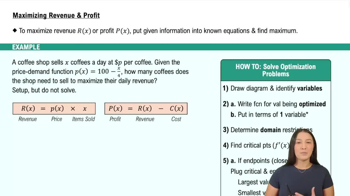Table of contents
- 0. Functions7h 52m
- Introduction to Functions16m
- Piecewise Functions10m
- Properties of Functions9m
- Common Functions1h 8m
- Transformations5m
- Combining Functions27m
- Exponent rules32m
- Exponential Functions28m
- Logarithmic Functions24m
- Properties of Logarithms34m
- Exponential & Logarithmic Equations35m
- Introduction to Trigonometric Functions38m
- Graphs of Trigonometric Functions44m
- Trigonometric Identities47m
- Inverse Trigonometric Functions48m
- 1. Limits and Continuity2h 2m
- 2. Intro to Derivatives1h 33m
- 3. Techniques of Differentiation3h 18m
- 4. Applications of Derivatives2h 38m
- 5. Graphical Applications of Derivatives6h 2m
- 6. Derivatives of Inverse, Exponential, & Logarithmic Functions2h 37m
- 7. Antiderivatives & Indefinite Integrals1h 26m
- 8. Definite Integrals4h 44m
- 9. Graphical Applications of Integrals2h 27m
- 10. Physics Applications of Integrals 2h 22m
5. Graphical Applications of Derivatives
Applied Optimization
Problem 4.3.111c
Textbook Question
Population models The population of a species is given by the function P(t) = Kt²/(t² + b) , where t ≥ 0 is measured in years and K and b are positive real numbers.
c. For arbitrary positive values of K and b, when does the maximum growth rate occur (in terms of K and b)?
 Verified step by step guidance
Verified step by step guidance1
To find when the maximum growth rate occurs, we need to determine the rate of change of the population, which is the derivative of the function P(t) with respect to time t. Start by finding the derivative P'(t) using the quotient rule.
The quotient rule states that if you have a function in the form of a quotient, u(t)/v(t), its derivative is given by (u'(t)v(t) - u(t)v'(t))/(v(t))^2. Here, u(t) = Kt² and v(t) = t² + b.
Calculate the derivatives: u'(t) = d/dt[Kt²] = 2Kt and v'(t) = d/dt[t² + b] = 2t.
Substitute these derivatives into the quotient rule formula to find P'(t): P'(t) = [(2Kt)(t² + b) - (Kt²)(2t)] / (t² + b)².
Simplify the expression for P'(t) and set it equal to zero to find the critical points. Solve for t to determine when the maximum growth rate occurs in terms of K and b.
 Verified video answer for a similar problem:
Verified video answer for a similar problem:This video solution was recommended by our tutors as helpful for the problem above
Video duration:
8mPlay a video:
Was this helpful?
Key Concepts
Here are the essential concepts you must grasp in order to answer the question correctly.
Population Growth Rate
The population growth rate refers to the change in population size over time, often expressed as a derivative of the population function with respect to time. In this context, it is essential to find the derivative of the function P(t) to determine when the growth rate is maximized, which involves analyzing critical points where the derivative equals zero.
Recommended video:

Intro To Related Rates
Critical Points
Critical points are values of the independent variable (in this case, time t) where the derivative of a function is either zero or undefined. These points are crucial for identifying local maxima and minima in the population growth function, as they indicate where the growth rate changes direction, helping to determine when the maximum growth occurs.
Recommended video:

Critical Points
Second Derivative Test
The second derivative test is a method used to classify critical points as local maxima, minima, or points of inflection. By evaluating the second derivative of the population function at the critical points found, one can confirm whether the growth rate is at a maximum, providing insight into the behavior of the population over time.
Recommended video:

The Second Derivative Test: Finding Local Extrema

 1:13m
1:13mWatch next
Master Intro to Applied Optimization: Maximizing Area with a bite sized video explanation from Callie
Start learningRelated Videos
Related Practice









